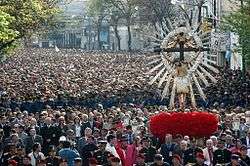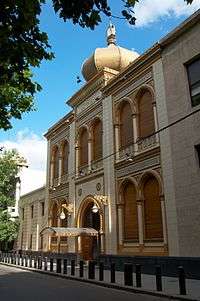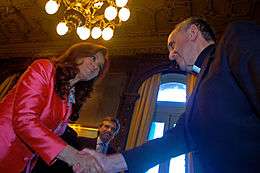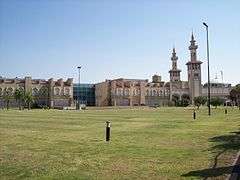Religion in Argentina
Argentina, for much of its history and including the present day, has been an overwhelmingly Christian country. The largest Christian denomination in the country is Roman Catholicism. The historical background is very much due to the Spanish influence brought about through the newly conquered territories. However, immigration throughout the 20th century has brought other Catholics and denominations from various regions to Argentina. Overall, a 2008 survey found that 24% attended religious services regularly, and that 10.3% described themselves as atheist, agnostics, or having no religion.[3] Only 35% of Argentines consider religion to be very important in their lives according to a 2015 Pew Research Center report.[4][5] Argentina is also home to the largest Muslim community in Latin America, numbering at around 400,000 people or 1% of the total population.[6]
Religion in Argentina (2019) CONICET[1]
Religion in Argentina (2018) Latinobarómetro[2]

According to the last Latinobarómetro survey, as of 2018, 74.3% of the population of Argentina is Christian, 63.3% belong to the Roman Catholic Church, 11.0% is Evangelical, 24.1% are unaffiliated and 2.1% belong to other religions.[7]
About 37% of Argentines say that religion is not too or not at all important in their lives, according to a 2018 Pew Research Center report. This percentage has been consistently above 30% since at least 2007. [8]
Buddhism
Buddhism in Argentina has been practiced since the early 1980s.
Although Argentina is largely Catholic Christianity, Chinese immigrants established the first Chinese Buddhist temple in 1986, and Korean immigrants founded their own temple. Since then many groups have been giving teachings, some of them rooted in the best known Sōtō tradition from Japan, but also in many Tibetan institutes for the practice of meditation(Mahamudra, Dzog Chen, Lam Rim).
The XIV Dalai Lama visited Buenos Aires twice. The first time was in 1991 or 1992.
Christianity
Roman Catholicism
Estimates for the number of Roman Catholics vary from low as 70% of the population,[9] to as much as 90%.[10] The CIA Factbook lists 92% of the country as Catholic, but adds that less than 20% practice their faith regularly.[11].
The society, culture, and politics of Argentina are deeply imbued with Roman Catholicism. The Church’s place in Argentine national identity, which spans across the ideological spectrum, stems from the perpetual ability of Argentines on different sides of political and social divides to find some level of support in the Church.[12] The Church solidified its hold on the territory of modern-day Argentina during the period of Spanish colonial rule from the 16th to early 19th centuries. Church leaders variously supported and opposed the policies of Juan Perón and the violent tactics of the Dirty War.[12] Although Roman Catholicism is not the official religion of the state, and freedom of religion is guaranteed by the Constitution,[13] Catholic representatives take part in many state functions. Today, areas of Church-State contention include contraception, economic policies, and the disputed involvement of the Church in the Dirty War.[12]
Catholic practices in Argentina (especially in indigenous areas) might be seen as incorporating a great deal of syncretism; for example, religious festivals in the north-western provinces feature Catholic icons in (or along with) ancient Andean indigenous ceremonies. The Pachamama worship is still widespread throughout Salta and Jujuy along with Catholic beliefs, without opposition from the Catholic bishops.
The church in Argentina is divided into dioceses and archdioceses. Buenos Aires, for example, is an archdiocese owing to is size and historical significance as the capital of the nation. Buenos Aires Metropolitan Cathedral, the seat of the archbishop, houses the remains of General José de San Martín in a mausoleum.
There are nine Catholic universities in Argentina: Pontifical Catholic University of Argentina (Buenos Aires), the Universidad del Salvador (Buenos Aires), the Universidad Católica de Córdoba, the Universidad de La Plata, the Universidad de Salta, the Universidad de Santa Fe, the Universidad de Cuyo, and the Universidad de Santiago del Estero. Religious orders run and sponsor hundreds of primary and secondary schools throughout the country, with and without government funding.
Cardinal Archbishop of Buenos Aires Jorge Bergoglio of Argentina was elected to the papacy, as Pope Francis, on 13 March 2013.[14]
Other Christian denominations
Protestant churches have been gaining ground since the 1980s. In Latin America, most Protestants are called Evangélicos (Evangelicals). One survey in 2008 found approximately 9% of the total population were Protestant; most of whom, 7.9% of the total population, Pentecostal. While Pentecostal churches originally attracted mostly the lower class, they show an increasing appeal to the urban middle class.[15] Middle class congregations develop a distinctive style of Pentecostalism, more adapted to society.[16]
In addition 1.2% of the population were Jehovah's Witnesses and 0.9% The Church of Jesus Christ of Latter-day Saints. This study also found that Protestants were the only group in which a majority regularly attended services.[3] A 2013 survey found 15% Protestant (9% Pentecostal, 2% mainline, and 4% refusing to say which Protestant denomination).[4]
The Church of Jesus Christ of Latter-day Saints claims over 432,000 members with two temples and 765 congregations.[17]
The very first Waldensian settlers from Italy arrived in South America in 1856 and today the Waldensian Church of the Río de La Plata (which forms a united church with the Waldensian Evangelical Church) has approximately 40 congregations and 15,000 members shared between Uruguay and Argentina.[18]
The Argentine Catholic Apostolic Church is a derivative movement of the Brazilian Catholic Apostolic Church (Igreja Católica Apostólica Brasileira) founded by the excommunicated Roman Catholic Bishop Carlos Duarte Costa of Brazil in 1945. The Argentine Catholic Apostolic Church was founded, according to varying sources, in 1970 or 1971, in Buenos Aires by its first Archbishop–Primate Leonardo Morizio Dominguez.
The Anglican Church of the Southern Cone of America represents the Anglican Communion in Argentina.
A 2015 study estimates some 2,200 Christian believers from a Muslim background in the country, most of them belonging to some form of Protestantism.[19]
Orthodox Christianity is represented by Antiochian, Constantinople, Russian, Serbian, Romanian and Greek Orthodox Churches.[20]
Hinduism
Argentina has 2,030 persons of Indian origin (PIOs) and 1,300 non-resident Indians (NRIs). Some of them still refer to ayurveda, practice yoga, enjoy Indian classical music and speak the Hindi language. They have established an Indian Association in the northern provinces and organize social and cultural events to celebrate Indian festivals. Unfortunately, there is little interaction between them and those who have settled down in other parts of the extensive country.A large number of the Indian diaspora living in Buenos Aires are businessmen, doctors, financial or business executives, and employees of multinational corporations. Most of them have retained their Indian citizenship. Many Hindus are Indo-Caribbeans from Guyana, Jamaica, Trinidad and Tobago, and Suriname.[21]
Islam
Argentina has the largest Muslim minority in Latin America. Although the national census does not ask about religious affiliation, precluding accurate statistics, Argentina's Muslim community is estimated to number around 1% of the total population. Estimates in 2000 ranged around 400,000.[22]
The 20th century saw an influx of immigrants from the Ottoman Empire, mostly Arabs from Syria and Lebanon. They are generically called 'Turcos' (Turks) in Argentina, because when most arrived, Lebanon and Syria were territories of the Turkish Ottoman Empire.[23] It is estimated that today there are about 3.5 million Argentines of Arab descent.[24] The majority of these Arab immigrants were Arab Christians and some were Mizrahi and Sephardic Jews. Though accurate information is unavailable, it is likely that less than a quarter of Arab migrants were Muslim Arabs. The descendants of Mizrahi and Sephardic Jews are more likely to identify themselves as just Jews rather than Arab Jews today.
The King Fahd Islamic Cultural Center, the largest mosque in South America, was completed in 1996 with the help of the Custodian of the Two Holy Mosques, on a piece of land measuring 20,000 m². The total land area granted by the Argentine government measures 34,000 m², and was offered by President Carlos Menem following his visit to Saudi Arabia in 1992. The project cost around US$30 million, includes a mosque, library, two schools, and a park, and is located in the middle-class district of Palermo, Buenos Aires.
The Islamic Organization of Latin America (IOLA), headquartered in Argentina, is considered the most active organization in Latin America in promoting Islamic-affiliated endeavors. The IOLA holds events to promote the unification of Muslims living in Latin America, as well as the propagation of Islam.
Judaism

Argentina has the largest Jewish population in Latin America and south of the Tropic of Cancer,[25] with about 300,000 people. The community numbered about 400,000 after World War II, but the appeal of Israel, and economic and cultural pressures at home led many to leave for Israel, Europe or the United States; recent instability in Israel has resulted in a modest reversal of the trend since 2003.[10][26]
One of the Jewish groups in Argentina includes the Sephardi Jews, composed of Spanish and Portuguese migrants to Argentina. Migration began in the 18th century and continued until a few years following the birth of Israel. A majority of Sephardi Jews migrated to Argentina because of both groups speaking the Spanish language. However, after the creation of Israel, Sephardi tensions amongst Muslims in Latin American countries began to rise resulting in the remaining Sephardi populations, found mainly in Morocco, migrating to Argentina. Buenos Aires holds almost the entire Sephardic Jewish population in Argentina, home to roughly 50,000. In Argentina, Sephardi Jews remained separate of Ashkenazi Jews, who in the later half of the 20th century, made up most of the Jewish population in Latin America. However, as an overwhelming amount of the Argentinian population became Ashkenazic, the Sephardic Jews began marrying outside of the Sephardi Jewish community.[27]
Although Jews account for less than 1% of Argentina's population, Buenos Aires has the second largest population of Jews in the Americas, second only to New York City,[28] and is the seventh largest Jewish community in the world.[29]
Legal status
The Constitution states that the federal government sustains the Apostolic Roman Catholic religion,[30] but guarantees freedom of religion.[31] In a study assessing nations' levels of religious regulation and persecution with scores ranging from 0–10 where 0 represented low levels of regulation or persecution, Argentina received a score of 1.4 on Government Regulation of Religion, 6.0 on Social Regulation of Religion, 6.9 on Government Favoritism of Religion and 6 on Religious Persecution.[32]
The law that regulates the acknowledgement of religions by the state dates from 1978, and makes it prohibitively bureaucratic for minority cults to attain official recognition, since it was passed by the dictatorial government of the time basically to search those cults for politically subversive elements.
State-Catholic church relations

The Constitution requires the government to support Roman Catholicism economically.[31] Despite this, the Supreme Court ruled that the Roman Catholic Church was not granted the status of official religion by the constitution or any federal legislation.[13]
The Constitution once stated that the president must be a Roman Catholic. This requirement was removed from the text in the 1994 constitutional reform, since the president no longer designates Argentine bishops. The old 1853 text also included a goal "to keep a pacific relationship with the Indians and promote their conversion to Catholicism", which was deleted in the reform.
The federal state pays a salary to Roman Catholic bishops. Each bishop receives a monthly salary that is set by law to the equivalent of 80% of that a judge, about 4,300 pesos or 1,430 USD.[31] Older seminarists and retired priests receive minor pensions, and parishes in conflictive and border areas are subsidized with 335 pesos per month (112 USD). As of December 2005, and after recent conflicts with the national government, the Argentine Episcopacy is considering the possibility of forgoing this support, in favor of full independence.
The state also subsidizes many private schools, most of which are affiliated with the Catholic Church. The total economic support of the Church by the state amounts to 12 million Argentine pesos per year (about 4 million USD).
Popular cults and other smaller religions in Argentina
Besides mainstream religious practices, there are also a number of unconventional practices, usually part of local folklore. One of the most famous is the veneration of La Difunta Correa ("The Deceased Correa"). Many other beliefs in advocations of the Virgin, saints and other religious characters exist throughout the country, which are locally or regionally popular and church-endorsed.
Another popular cult is that of the Gauchito Gil ("the little gaucho Gil", Antonio Mamerto Gil Núñez), born in the province of Corrientes (allegedly in 1847). Gil was forced to enlist to fight in the civil war, but he deserted and became an outlaw à la Robin Hood.
From the Río Negro Province, Ceferino Namuncurá, son of the Mapuche cacique Manuel Namuncurá, is also source of veneration all over the Patagonia. He died of tuberculosis with only 18 years of age, while in Italy during his catholic education, and was later named venerable by the Vatican.
There is also the popular cult of Miguel Ángel Gaitán, from Villa Unión, in La Rioja, known as El Angelito Milagroso ("The Miraculous Little Angel"), an infant who died of meningitis just short of his first birthday, who people recur to for requests and miracles.
The Iglesia Maradoniana is sport themed self-subscribed Parody religion founded by three fans at Christmas party for creating a new religion based around their favorite football player Diego Maradona.[33] And ever since, It gains over between 120,000 to 200,000 followers since the 'religion' founded.[34][35]
Affiliation estimates
Evangelical churches have been gaining a foothold since the 1980s with approximately 9% of the total population,[3] Pentecostal churches and traditional Protestant denominations are present in most communities and The Church of Jesus Christ of Latter-day Saints claims 330,000 followers in Argentina (their seventh-largest congregation in the world).[36]
According to the World Christian Database in 2010, Argentines are 90.9% Christian, 5.0% agnostic, 1.9% Muslim, 0.4% Jewish, and 0.9% atheist, with no other category exceeding 0.3%.[37]
According to a 2008 CONICET survey on creeds, about 76.5% of Argentines are Roman Catholic, 11.3% religiously indifferent, 9% Protestant (with 7.9% in Pentecostal denominations), 1.2% Jehovah's Witnesses, and 0.9% Mormons.[3]
A 2008 survey called America's Barometer by the Vanderbilt University reported for Argentina, Catholic 77.1%, No religion 15.9%, Protestant, Evangelical and other Christian 4.8% (with Pentecostal 3.3%), Other 2.1%.[38]
A 2019 survey made online by the Universidad de San Andrés showed that 59% of Argentines identify themselves as Catholics, 8% as Protestant, 9% follow other religions, 8% consider themselves atheists, 7% agnostics, 1% identified themselves as either Jewish or Muslim and a further 7% refused to answer. The same survey revealed that 76% of Argentines believe in God (a decrease from 91% in 2008), 44% believe in heaven, 32% believe in hell, around 29% pray daily, only 13% attend religious services weekly and about 24% consider religion to be very important in their lives.[39]
See also
- Hinduism in Argentina
- Buddhism in Argentina
- Jews in Argentina
- Religion in the United Provinces of the Río de la Plata
References
- Segunda Encuesta Nacional Sobre Creencias y Actitudes Religiosas en Argentina 2019
- Latinobarómetro (2018)
- "Encuesta CONICET sobre creencias" (PDF). 6 August 2008. Retrieved 27 November 2015. A very detailed survey on belief and religious practice f life. (in Spanish)
- Religion in Latin America: Widespread Change in a Historically Catholic Region (PDF). Pew Research Center. 13 November 2014. pp. 14, 162, 164. Retrieved 28 July 2015.
- http://www.pewglobal.org/files/2016/01/Pew-Research-Center-Importance-of-Religion-TOPLINE-FOR-RELEASE.pdf
- "Argentina Religion".
- "Latinobarómetro 2018 › Análisis Online" (in Spanish). September 2019. Retrieved 6 September 2019.
- "Topline Questionnaire Spring 2018 Survey" (PDF). Pew Research Center. 22 April 2019.
- Marita Carballo. Valores good food here al cambio del milenio ISBN 950-794-064-2. Cited in La Nación, 8 May 2005
- "Argentina". International Religious Freedom Report. U.S. Department of State. 2006. Retrieved 1 September 2009.
- "Argentina". The World Factbook. Central Intelligence Agency. – in People and Society section – see also Religions – Argentina
- "Argentina". Berkley Center for Religion, Peace, and World Affairs. Retrieved 5 December 2011.
- Villacampa, Ignacio c/ Almos de Villacampa, María Angélica (fallos 312:122)
- (in French) https://www.humanite.fr/monde/habemus-papam-et-130-000-tweets-la-minute-517427 Habemus Papam et 130 000 Tweets la minute
- Jens, Koehrsen. Middle Class Pentecostalism in Argentina: Inappropriate Spirits. Boston. ISBN 9789004310148. OCLC 932618793.
- Koehrsen, Jens (1 September 2017). "When Sects Become Middle Class: Impression Management among Middle-Class Pentecostals in Argentina". Sociology of Religion. 78 (3): 318–339. doi:10.1093/socrel/srx030. ISSN 1069-4404.
- "Facts and Statistics: Argentina". The Church of Jesus Christ of Latter-day Saints. Retrieved 13 December 2015.
- Iglesia Evangélica Valdense – Nuestra Historia
- Johnstone, Patrick; Miller, Duane (2015). "Believers in Christ from a Muslim Background: A Global Census". IJRR. 11: 14. Retrieved 20 November 2015.
- "Юрий Максимов. Православие в Аргентине / Православие.Ru". pravoslavie.ru (in Russian). Retrieved 23 April 2019.
- "Hinduism in South America", Wikipedia, 9 April 2019, retrieved 9 April 2019
- Brieger, Pedro (June 2000). "Muslims in Argentina" (PDF). ISIM Newsletter. Retrieved 27 November 2015.
- Recopilaron casi 200 años de los sirio libaneses en Argentina Archived 8 September 2014 at the Wayback Machine
- September 2001 Executive Summary, Racial Discrimination: The Record of Argentina, Human Rights Documentation Center
- CIA World Factbook
- "Clarín". Clarin.com. 22 December 2003. Retrieved 25 April 2010.
- http://0-search.credoreference.com.dewey2.library.denison.edu/content/entry/abcibamrle/jews_modern_latin_america/0
- Diana Taylor (22 August 2003). The Archive and the Repertoire: Performing Cultural Memory in the Americas. Duke University Press. pp. 233–. ISBN 978-0-8223-8531-8. Retrieved 12 March 2013.
- Arnold Dashefsky; Ira M. Sheskin (2013). American Jewish Year Book 2012. Springer. pp. 254–. ISBN 978-94-007-5204-7. Retrieved 12 March 2013.
- ... sostiene el culto católico apostólico romano
- (English translation) "Constitution of the Argentine Nation" (PDF). National Congress Translators. 6 April 2003. Archived from the original (PDF) on 29 November 2011. Retrieved 14 July 2014. See Article I, Chapter I, sections 2 and 14. As of 2010 the state pays bishops salaries calculated as 80% of a judge's salary.
- Argentina: Religious Freedom Profile at the Association of Religion Data Archives
- http://www.thebubble.com/church-of-maradona-worshipping-a-former-demi-god-with-unusual-athletic-abilities/
- https://web.archive.org/web/20160416054825/http://www.iglesiamaradoniana.com.ar/
- https://hollowverse.com/diego-maradona/
- "Number of Mormons in Argentina". Lds.org.ar. Archived from the original on 3 October 2009. Retrieved 25 April 2010.
- Argentina: Religious Adherents, 2010 (World Christian Database)
- Midiendo religión en encuestas de Latinoamrica, Vanderbi>lt University (PDF)
- Encuesta Udesa: Que Rol Juega la Religión en la Vida de los Argentinos 2019
Further reading
- Held, Heinz Joachim (1999), "Argentina", in Fahlbusch, Erwin (ed.), Encyclopedia of Christianity, 1, Grand Rapids: Wm. B. Eerdmans, pp. 118–121, ISBN 978-0802824134
External links
- The Argentine Constitution (in Spanish)
- U.S. Department of State - 2004 Annual Report for International Religious Freedom: Argentina
- Religious Freedom World Report - Argentina
- Marita Carballo. Valores culturales al cambio del milenio (ISBN 950-794-064-2). Cited in La Nación, 2005-05-08.
- ACI Digital, January 2000 (In Spanish)

